1 Oct 2025
Have you noticed how robots are no longer just in sci-fi movies?
They’re everywhere—and not just in factories. Robots now assist surgeons in delicate heart surgeries, deliver groceries in some cities, and even patrol malls as security bots. Amazon uses over 750,000 robots in its warehouses to speed up deliveries. And yes, the robot vacuum in your living room is part of this revolution (Source: Amazon.com).
So, what exactly is robotics? At its core, robotics is about machines that can sense, decide, and act—often powered by AI. These machines come in many forms: robotic arms assembling cars, drones inspecting power lines, humanoid robots greeting customers, and swarms of tiny bots working together like ants.
In this post, we’ll explore the most exciting areas of robotics, from humanoid robots that mimic human movement to autonomous swarms that could change agriculture and disaster response. We’ll also look at how these innovations are reshaping industries—and what that means for your daily life. Now, let’s break down the world of robotics into a few key categories:
- Industrial Robotics – robots that work in factories and plants.
- Service Robotics – robots that provide services outside of manufacturing (like in Hospitality, cleaning etc.)
- Medical Robotics – robots specifically used in operation theatre.
- Autonomous Systems – self-driving vehicles and drones (robots that move on their own).
- AI Integrated Robots – New Generation Robots like Swarm Robots, Humanoids, etc.
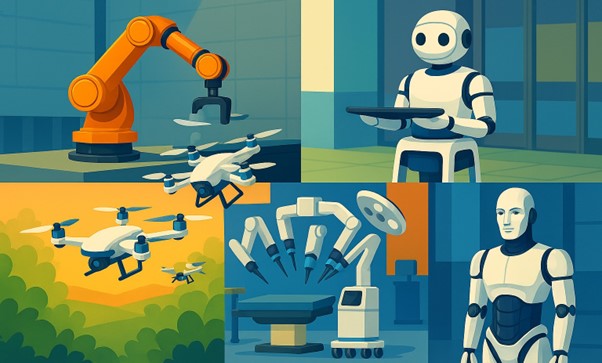
Along the way, we’ll highlight some recent innovations (humanoid robots, collaborative robots, swarms of robots) and real-world examples. We’ll also see how robots are changing industries like manufacturing, healthcare, logistics, and consumer products.
Grab your mental toolkit – off we go into the land of robots!
When you hear “robot,” do you picture a giant mechanical arm welding a car body? That’s an industrial robot. These are the robots that have been in factories for decades, handling repetitive or heavy tasks with speed and precision.
In logistics, warehouse bots and delivery drones speed up operations. At home, they clean floors and lawns, while robotic pets offer companionship. Hotels use robot butlers, malls have info kiosks and patrol bots, and some restaurants feature robot waiters. These are examples of Service Robots.
One of the most fascinating and life-changing areas of robotics is in healthcare. Medical robots range from highly specialized surgical machines to friendly therapy robots. Surgical robots like Da Vinci enable minimally invasive procedures with high precision, fully controlled by surgeons. Rehabilitation and assistive robots including exoskeletons and smart prosthetics help patients regain mobility and offer natural movement with sensory feedback. In hospitals, robots deliver supplies, dispense medication, and support remote consultations via telepresence.
Autonomous systems include self-driving cars, robo-taxis, trucks, and drones—blending robotics with AI. Waymo operate robotaxis on pilot basis in select cities. Some companies have demonstrated success in autonomous trucks and buses with aim to improve efficiency and tackle driver shortages. Drones handle delivery, farming, surveillance, and rescue, from medical drops in Rwanda to NASA’s Mars helicopter.
You can’t discuss modern robotics without talking about Artificial Intelligence (AI). Think of AI as the brain and robots as the body. A robot needs smarts to decide when to move, what it’s looking at, or how to plan a task. That’s where AI comes in – giving robots perception, decision-making, and even learning abilities.
AI: The Brain Behind the Bot
AI powers modern robots with key capabilities. Computer vision lets them see and interpret surroundings. Machine learning helps them improve through experience. Natural language and social AI enable voice interaction and emotional awareness, useful in care and education. Autonomy algorithms guide self-driving vehicles and drones. In factories, smart robots use AI for predictive maintenance and flexible task handling.
Cool New Frontiers: Humanoids, Cobots, and Swarm Robots
Now that we’ve covered the basics, let’s talk about a few “cool kids” of robotics – the trending innovations that often make headlines and spark imaginations:
Humanoid robots are robots designed to look and/or move like humans – typically with two legs, two arms, a torso, and a head (though not always a face). Why humanoid? The idea is they can potentially navigate the human world better, use tools made for people, and perhaps even socially interact. Tesla’s Optimus is designed for general-purpose tasks and has been demonstrated performing actions like picking up items and pouring drinks. While the Collaborative robots (cobots) are robots designed to work directly alongside people. Instead of replacing a worker, a cobot is more of an assistant.
Swarm robotics is about coordinating large numbers of simple robots to work together, inspired by how ants or bees operate. Instead of one super-smart robot, you have maybe 50 or 100 somewhat dumb robots, but collectively they achieve something complex.
This is still largely experimental, but possible uses include:
Swarm robotics enables many small robots to work together efficiently. In warehouses, dozens of bots can pick items simultaneously. In agriculture, swarms weed, plant, or pollinate like robotic bees. For search and rescue, tiny bots crawl through debris to find survivors. In defence, drone swarms are being explored for surveillance and tactical use.
Robotics in India:
India is actively adopting and innovating in the field of robotics across various sectors.
Practical Applications:
- In Restaurant: At Yellow House Robot Restaurant, robotic servers named Ruby and Diva deliver dishes with precision and charm. These intelligent robots seamlessly integrate table-specific data to ensure smooth and personalized service, redefining the dining experience through cutting-edge automation.
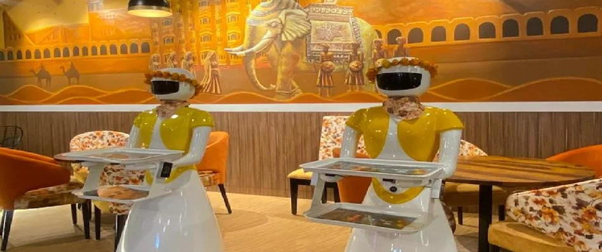
- In Healthcare: Combining cutting-edge technology with medical innovation, doctors used India’s first indigenous surgical tele-robotic system to successfully conduct two complex heart surgeries over a distance of 286 kilometres – the longest, physical separation so far achieved in India between a patient and the operating surgeon.
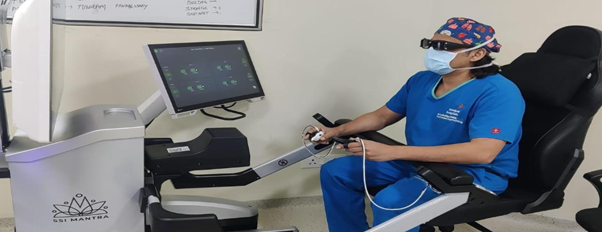
- In Defence: DRDO’s R&D Establishment developed Daksh, a robot for detecting and neutralizing threats. It’s now used by the Indian Army and Police for anti-terror and anti-sabotage missions.
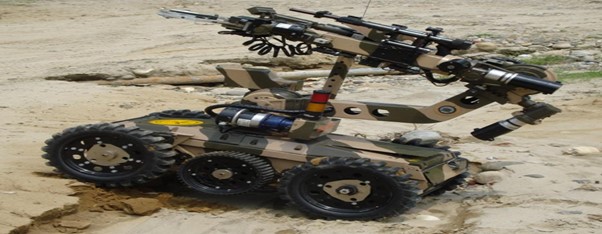
- In Infrastructure: EyeROV TUNA is a compact underwater drone. It handles tough underwater tasks like inspecting ship hulls, dams, ports, bridges, and fish farms.

Robotics Growth in India:
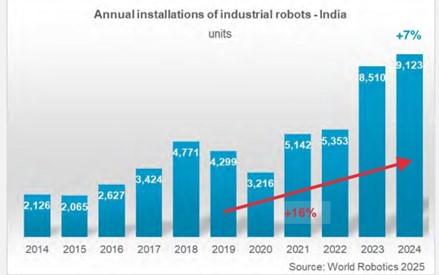
In India, sales of industrial robots reached a new record of 9,123 units installed. This marks a 7% increase compared to the previous year. India is now the sixth-largest installer worldwide, behind Germany, Korea, the USA, Japan and China. This demonstrates India's enormous growth potential.
Considering industry-wise annual installations in India, the automotive sector leads in absolute numbers with 4,073 units in 2024, marking an all-time high for the second consecutive year. In terms of Year-on-Year growth, the plastics and chemicals industry saw the largest surge at 33%, while robot adoption in the metal industry grew 30% in 2024.
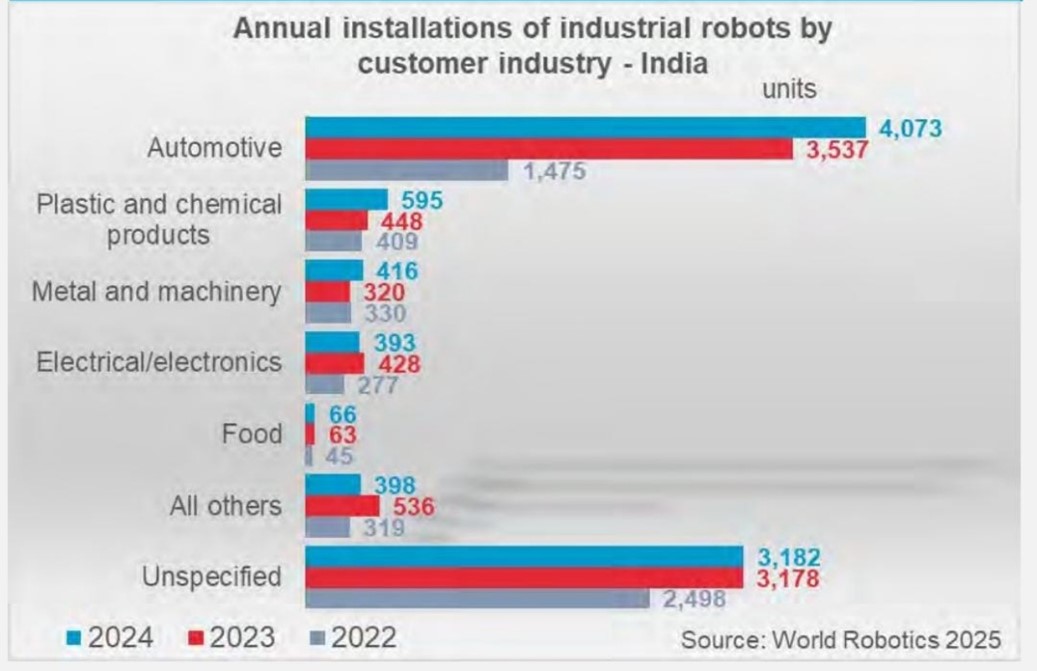
India’s Bet on Robotics Innovation - From Classrooms to Startups
India is making significant and growing investments in robotics, both at the national and state levels. The Union Budget 2025-26 allocated ₹20,000 crore for science and technology research, including robotics, and established new Centres of Excellence and skilling programs focused on advanced automation. States like Maharashtra have announced dedicated budgets, such as ₹500 crore for robotics and AI, while Telangana has launched India’s first state robotics framework, including plans for a Robo Park and robotics labs in schools. Government is also supporting startups through schemes like TIDE 2.0 and deep tech investment alliances. These efforts are complemented by the expansion of Atal Tinkering Labs and the integration of robotics into school and technical curricula, aiming to foster innovation and skill development from an early age.
Looking Ahead: Challenges, Ethics, and Human Side of Robotics
As robotics becomes more integrated into society, new challenges and questions arise. Ethics and regulation are at the forefront: How do we ensure robots act safely and fairly, especially in sensitive areas like healthcare, law enforcement, or autonomous vehicles? Governments and industry bodies are working to develop standards for safety, privacy, and accountability, but keeping pace with rapid innovation is a constant struggle.
Workforce impact is another major concern. While robots can take over repetitive, dangerous, or physically demanding jobs, they also create new roles in robot design, programming, maintenance, and oversight. The shift means workers will need to adapt, reskill, and embrace lifelong learning. Education systems and companies must prepare people for a future where collaboration with robots is routine.
Social acceptance is evolving as robots become more visible in homes, workplaces, and public spaces. People may feel uneasy about robots making decisions, handling personal data, or replacing human interaction. Building trust requires transparency, clear communication about what robots can and cannot do, and thoughtful design that respects human values.
Robots also open up new possibilities: They can support disaster response, environmental monitoring, and care for the elderly or disabled. Swarm robots might help clean oceans or restore ecosystems. Humanoid robots could assist in dangerous jobs or provide companionship. As robots become more capable, the focus will shift from simple automation to true partnership humans and machines working together to solve complex problems and improve quality of life.
“Building the Future, Side by Side for a Smarter World”.
MUTUAL FUND INVESTMENTS ARE SUBJECT TO MARKET RISKS, READ ALL SCHEME RELATED DOCUMENTS CAREFULLY.
The stocks/sectors mentioned do not constitute any kind of recommendation and are for information purpose only. Kotak Mahindra Mutual Fund may or may not hold position in the mentioned stock(s)/sector(s). These materials are not intended for distribution to or use by any person in any jurisdiction where such distribution would be contrary to local law or regulation. The distribution of this document in certain jurisdictions may be restricted or totally prohibited and accordingly, persons who come into possession of this document are required to inform themselves about, and to observe, any such restrictions.


